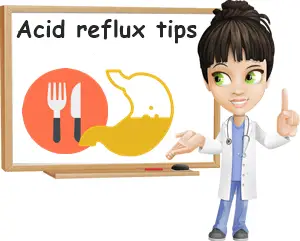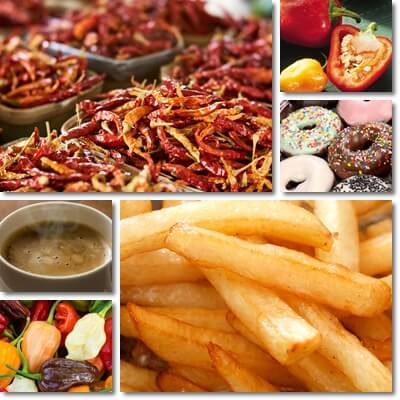Do you have bad acid reflux? Do you seem to not be able to relieve your acid reflux? Is everything you eat a trigger? Are you eating all the right foods that are presumably good for acid reflux, but still dealing with frequent episodes? Is your only option at this point relieving acid reflux symptoms without actually being able to treat or get rid of the underlying issue? What is there left to do for you?
If you’ve been battling recurring episodes of bad acid reflux and can’t seem to see the light at the end of the tunnel despite putting in all the effort diet and lifestyle-wise, then this article is for you.
Take it from someone who has gone through the exact same thing as you: if your acid reflux is persisting despite going great lengths to getting rid of it, then there are likely things you are not doing, or doing right, and dietary and lifestyle changes you are not completely committing to.

This is a hard thing to hear. And even harder to come to terms with because it sounds like you are not doing your part or putting in enough effort towards your health.
When you actually are. But a lot of the advice you may be following to the T is likely not coming from people who have gone through your experience. If your current diet for acid reflux does not seem to be working and you are still having recurrent attacks of really bad acid reflux, then this article is for you.
Read my top 7 diet tips for acid reflux
1) You are eating too much at once – keep to recommended portion sizes
If your acid reflux does not seem to be responding to changes in your diet, then it’s likely you are eating too much at once. Recommended serving sizes for most foods are a lot smaller than most people eat. For example, the recommended serving size for pasta is 85 grams. Most people eat more than that, double even.
And if you eat more pasta, you automatically also eat more pasta sauce. And pasta sauce always has oil or butter in it, sometimes also other types of fat from meat, cream or cheese. And tomato juice or sauce or paste. Or lemon juice. And most of these foods are known triggers for acid reflux, almost sure to cause an acid reflux attack in people with an active condition, more so when intakes are beyond a certain amount.
Portion control is vital for preventing, managing and treating acid reflux disease. If you are on a diet for acid reflux, then it could help you tremendously to research portion sizes for various foods you are eating such as pasta, bread, meats, cheese and dairy, fish and seafood, fruit and so on.

2) You are eating foods you shouldn’t be eating – stick to the diet
Acid reflux has its triggers, foods that you should absolutely avoid eating if you have acid reflux, especially really bad acid reflux. Of course, not all people respond the same way to the same foods so the list of foods to avoid for acid reflux can stand some tweaks. But for the most part, most people with really bad acid reflux should avoid the same foods.
Are you being strict enough with your acid reflux diet? Or have you sneaked in some chocolate or ice cream, a slice of pizza, garlic bread or spaghetti with garlic or onions? How about coffee or matcha, or green tea?
Foods that are generally bad for acid reflux include:
- Garlic, onion, leek, fresh or dried.
- Tomato sauce, tomato juice, tomato paste and even fresh tomatoes.
- Citrus fruit and citrus juice: lemon, lime, yuzu, sweet oranges, grapefruit etc.
- Fruit and vegetable juices, bought or home made.
- Soda, energy drinks, even some carbonated water.
- C0ffee, caffeinated beverages (e.g. energy drinks, green tea, matcha), green tea and company.
- Cocoa, chocolate and other byproducts.
- Spices and spicy foods: spicy peppers (chili peppers, cayenne), horseradish, pepper, ginger, wasabi.
- Spicy, acidic or fermented condiments: relishes, sauces (e.g. soy sauce, fish sauce), vinegar, mustard, horseradish dip etc.
- Matured cheeses (e.g. cheddar, parmesan, gouda) and fermented dairy (e.g. kefir, soured milk, buttermilk, Greek yogurt, fruit yogurt, yogurt drinks, any yogurt).
- Processed foods from candy and chips to frozen meals.
- Canned foods (e.g. canned tuna or other fish, in brine, oil, lemon juice or tomato sauce, canned tomatoes, tomato juice or sauce).
- Oily fish and seafood (e.g. salmon, tuna).
- Fried foods such as French fries or fried fish.
- Fatty foods, overly seasoned foods, heavy foods (e.g. red meat).
- High-fiber, gassy foods: legumes (lentils, chickpeas, beans, peas), cabbage, Brussels sprouts, broccoli, cauliflower etc.
- Particular foods: pineapple, sweet peppers, cucumbers, eggplant, tomatoes, papaya, bananas, apples.
- Fermented, marinated, pickled foods: pickled fruit and vegetables, marinated olives etc.
- Alcoholic beverages of any kind.
3) You are pairing foods the wrong way – switch up your menu
Certain combinations of foods favor acid reflux. So if you have a bad acid reflux attack, try to think what you ate and which foods you paired together. Switching up the way you eat can make a world of a difference for your acid reflux. And yes, it might not be what you’re used to eating, it might not seem very flavorful, but it’ll help with your acid reflux and you’ll also end up appreciating foods for their natural more, even if it might not seem so at first.
For breakfast, instead of toast with butter and jam, or bacon and fried eggs, try having plain mashed avocado with salt on your bread. If avocado is bad for your acid reflux, try poached eggs on toast, or a herbal tea with toast and raw honey, if you are not allergic.
For lunch, if you are having spaghetti, instead of pairing your pasta with a classic tomato sauce, try adding roasted vegetables such as zucchini and portobello mushrooms, and a tablespoon of raw extravirgin olive oil for more flavor. You can eat the pasta warm, or cold.
For dinner, instead of pizza or something pre-made or frozen, just simmer down some spinach, pair with a couple of boiled potatoes and boiled chicken legs without skin. Season plainly with salt and maybe a fresh tablespoon of extravirgin olive oil. For more inspiration, see my 1 week gastritis diet.
4) Your meals are too complex – consider eating just a few foods per meal
The best tasting dishes are complex, full of different ingredients for optimal flavor. Garlic, onions, spring onions or chives, chili peppers, spicy or smoked paprika, ginger, turmeric, soy sauce, fish sauce, they all give excellent flavor to food.
But when you have acid reflux, really bad acid reflux, your meals should be simple, made up of just a few ingredients and seasoned lightly with just salt and a tablespoon of unrefined oil such as extravirgin olive oil. Yes, it’s not ideal, but it’s what works for acid reflux.
You can have spaghetti, but make it with grilled vegetables such as zucchini, golden zucchini, oyster mushrooms, portobello mushrooms or white button mushrooms, even porcini, seasoned with salt and one tablespoon of extravirgin olive oil.
You can have risotto, but make it with simmered down spinach, pumpkin or butternut squash, zucchini, mushrooms such as porcini, chanterelle or portobello, and fresh parsley, seasoned lightly with just salt and fresh extravirgin olive oil.
5) You are not cooking enough – cook as much as you can of what you eat
Complex, rich, perfectly seasoned and savory meals are the epitome of gourmet eating. But they’re often also full of butter or oil, spices and all sorts of ingredients that will cause your GERD to act up. Try as you might, there’s little chance of finding diet food made for people with digestive issues such as acid reflux disease, or gastritis, outside your own kitchen.
When you have acid reflux it’s vital that you cook, or otherwise prepare as much as you can of what you eat. Make your breakfast yourself (e.g. toast with raw honey and a herbal tea or soft boiled eggs on bread). Pack your lunch from home (e.g. a cold penne pasta with grilled zucchini or squash and mushrooms).
Make dinner when you get home (e.g. boiled vegetables with grilled chicken). Yes, it takes time that you don’t always have. But it’s the only way to make sure you are actually following through with your acid reflux diet.
6) You may need to go on a diet – losing even just a bit of weight helps with acid reflux
Losing weight is good for you when you have acid reflux and can make a world of a difference for your condition. For one, excess weight is weighing you down and belly fat in particular is more likely to trigger an acid reflux attack. And sometimes it’s not just the excess weight itself. It’s also the fact that, if you pack a few extra pounds, you are likely not eating right either, hence the acid reflux episodes.
Going on a diet will help you lose excess weight which is good for acid reflux. Also, going on a diet should entail eating cleaner, not just eating less, as well as eating less fatty foods or processed foods or heavy, complex, high calorie meals that are also problematic foods for acid reflux.
7) You’re relying too much on medication – you’ll know if you are eating right only when you stop relying on antacids
A lot of people with acid reflux think they are eating all the right foods and seem to be noticing improvements in their condition. But how can you really know if you are eating right if you are taking medication to neutralize or reduce excess stomach acid production? Once you’ve figured out how to eat for acid reflux, and have been doing it right for a couple of weeks, you shouldn’t need antacids anymore. Or proton pump inhibitors. Are you still relying on them for everyday use?
